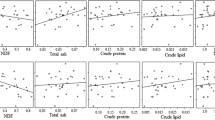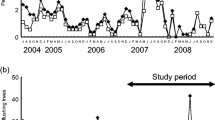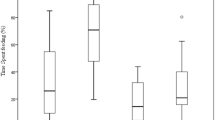Summary
Samples of leaves and fruits exploited as food items byTrachypithecus auratus sondaicus were analysed for nitrogen content, acid detergent fibre (ADF), pepsin cellulase digestibility (CDIG), condensed tannins (CT), total phenolics (TP) and protein precipitation capacity (PP) and compared with fruits and leaves not eaten. Differences in chemical measures for items eaten and not eaten were not statistically significant but trends indicate that leaves may have been selected for their lower fibre content and greater digestibility. Fruits eaten also had a higher mean level of CDIG and lower mean level of ADF than fruits not eaten but these measures are not considered to be of major importance in fruit selection as CDIG was lower and ADF higher in fruits eaten than in leaves eaten. Levels of CT, TP and PP capacity were higher in fruits eaten than in fruits not eaten but lower in leaves eaten than in leaves not eaten. The role of tannins and phenolics in food selection is discussed. Leaves (and fruits) were not strongly selected on the basis of protein content. Approximately half the dietary intake ofT. auratus sondaicus was leaves, a protein-rich food source. Possibly, protein levels in foliage at Pangandaran were sufficient that selection for this nutrient was not required. A nutrient other than protein (for example, soluble carbohydrates) may have been maximised through food selection. The protein/ADF ratio may provide an indicator of the acceptability of foliage in a habitat as potential food for a colobine. However, this ratio did not govern food selection byT. auratus sondaicus at Pangandaran.
Similar content being viewed by others
References
Asquith TN, Butler LG (1985) Use of dye-labelled protein as spectrophotometric assay for protein precipitants such as tannin. J Chem Ecol 11:1535–1544
Baranga D (1983) Changes in chemical composition of food parts in the diet of colobus monkeys. Ecology 64:668–673
Bate-Smith EC (1973) Tannins of herbaceous legumes. Phytochemistry 12:1809–1812
Bauchop T, Martucci RW (1968) Ruminant-like digestion of the langur monkey. Science 161:698–700
Bennett EL (1983) The banded langur: ecology of a colobine in West Malaysian rain forest. Unpublished PhD thesis, University of Cambridge
Burns RE (1971) Method for estimation of tannin in sorghum grain. Agron J 65:511–512
Chivers DJ, Hladik CM (1984) Diet and gut morphology in primates. In: Chivers DJ, Wood BA, Bilsborough A (eds) Food acquisition and processing in primates. Plenum Press, London, pp 213–230
Choo GM, Waterman PG, McKey DB, Gartlan JS (1981) A simple enzyme assay for dry matter digestibility and its value in studying food selection by generalist herbivores. Oecologia 49:170–178
Coley PD (1983) Herbivory and defensive characteristics of tree species in a lowland tropical forest. Ecol Monogr 53:209–233
Cork SJ, Pahl L (1984) The possible influence of nutritional factors on diet and habitat selection by the ringtail possum (Pseudocheirus peregrinus). In: Smith AP, Hume ID (eds) Possums and gliders. Australian Mammal Society, Sydney, pp 269–276
Davies AG (1984) An ecological study of the red leaf monkey (Presbytis rubicunda) in the dipterocarp forest of northern Borneo. Unpublished PhD thesis, University of Cambridge
Davies AG (1991) Seed-eating by red leaf monkeys (Presbytis rubicunda) in dipterocarp forest of northern Borneo. Int J Primatol 12:119–144
Davies AG, Caldecott JO, Chiver DJ (1983) Natural foods as a guide to the nutrition of Old World primates. In: Remfry J (ed) Standards in laboratory animal management. U.F.A.W., Potters Bar, pp 225–244
Davies AG, Bennett EL, Waterman PG (1988) Food selection by two South-east Asian colobine monkeys (Presbytis rubicunda andPresbytis melalophos) in relation to plant chemistry. Biol J Linn Soc 34:33–56
Gartlan JS, McKey DB, Waterman PG, Mbi CN, Struhsaker TT (1980) A comparative study of the phytochemistry of two African rain forests. Biochem Syst Ecol 8:401–422
Goltenboth R (1976) Non human primates (apes, monkeys and prosimians). In: Klos H-G, Lang EM (eds) The handbook of zoo medicine (translation). Van Nostrand Reinhold, New York, pp 46–85
Hladik CM (1977) A comparative study of the feeding strategies of two sympatric species of leaf monkeys:Presbytis senex andPresbytis entellus. In: Clutton-Brock TH (ed) Primate ecology: Studies of feeding and ranging behaviour in lemurs, monkeys and apes. Academic Press, London, pp 323–353
Janis C (1976) The evolutionary strategy of the Equidae and the origins of rumen and caecal digestion. Evolution 30:757–774
Janzen DH (1974) Tropical blackwater rivers, animals and mast fruiting by the Dipterocarpaceae. Biotropica 6:69–103
Janzen DH, Waterman PG (1984) A seasonal census of phenolics, fibre and alkaloids in foliage of forest trees in Costa Rica: some factors influencing their distribution and relation to host selection by Sphingidae and Saturniidae. Biol J Linn Soc 21:439–454
Jones WT, Mangan JL (1977) Complexes of the condensed tannins of sainfoin (Onobrychis viciifolia Scop.) with fraction-1 leaf protein and submaxillary mucoprotein and their reversal with polyethylene glycol and pH. J Sci Food Agric 28:126–136
Kleiber N (1961) The fire of life. John Wiley & Sons, New York
Kool KM (1989) Behavioural ecology of the silver leaf monkey,Trachypithecus auratus sondaicus, in the Pangandaran Nature Reserve, West Java, Indonesia. PhD thesis (unpublished), The University of New South Wales, Australia
Kool KM (1992) The diet and feeding behaviour of the silver leaf monkey,Trachypithecus auratus sondaicus, in Indonesia. Int J Primatol (in press)
McKey DB (1978) Soils, vegetation and seed eating by black colobus monkeys. In: Montgomery GG (ed) The ecology of arboreal folivores. Smithsonian Institution Press, Washington D.C., pp 423–437
McKey DB, Gartlan JS, Waterman PG, Choo GM (1981) Food selection by black colobus monkeys (Colobus satanas) in relation to plant chemistry. Biol J Linn Soc 16:115–146
McManus JP, Davis KG, Lilley TH, Haslam E (1981) The association of proteins with polyphenols. J Chem Soc Chem Commun 7:309–311
Martin JS, Martin MM (1982) Tannin assays in ecological studies: lack of correlation between phenolics, proanthocyanidins and protein-precipitating constituents in mature foliage of six oak species. Oecologia 54:205–211
Moir KW (1982) Theory and practice of measuring the cell-wall content of food for ruminant and non-ruminant animals. Lab Pract 31:732–733
Mole S, Waterman PG (1987a) A critical analysis of techniques for measuring tannins in ecological studies I. Techniques for chemically defining tannins. Oecologia 72:137–147
Mole S, Waterman PG (1987b) Tannins as antifeedants to mammalian herbivores — still an open question? In: Waller GR (ed) Allelochemicals: Role in agriculture and forestry. American Chemical Society Symposium Series, Washington, pp 572–587
Moreno-Black GS, Bent EF (1982) Secondary compounds in the diet ofColobus angolensis. Afr J Ecol 20:29–36
Newbery DMcC, Gartlan JS, McKey DB, Waterman PG (1986) The influence of drainage and soil phosophorus on the vegetation of Douala-Edae Forest Reserve, Cameroun. Vegetatio 65:149–162
Oates JF (1977) The guereza and its food. In: Clutton-Brock TH (ed) Primate ecology: Studies of feeding and ranging behaviour in lemurs, monkeys and apes. Academic Press, London, pp 275–321
Oates JF (1988) The diet of the olive colobus monkey.Procolobus verus, in Sierra Leone. Int J Primatol 9:457–478
Oates JF, Swain T, Zantovska J (1977) Secondary compounds and food selection by colobus monkeys. Biochem Syst Ecol 5:317–321
Oates JF, Waterman PG, Choo GM (1980) Food selection by the South Indian leaf-monkey,Presbytis johnii, in relation to leaf chemistry. Oecologia 45:45–56
Reed J, Soller H (1987) Phenolics and nitrogen utilization in sheep fed browse. In: Rose M (ed) Herbivore nutrition research — Proceedings from second international symposium on the nutrition of herbivores, Univ. of Queensland, Brisbane. Australian Society of Animal Production, Canberra, pp 47–50
Roonwal ML, Mohnot SM (1977) Primates of south Asia — Ecology, sociobiology and behavior. Harvard University Press, Cambridge
Schmidt-Nielsen K (1972) Locomotion: energy costs of swimming, flying and running. Science 177:222–228
SPSS (1990) Advanced Statistics User's Guide. Marija J. Norusis/SPSS Inc., Chicago
Struhsaker TT (1975) The red colobus monkey. University of Chicago Press, Chicago
van Soest PJ (1963) Use of detergents in the analysis of fibrous feeds II A rapid method for the determination of fibre and lignin. J Assoc Off Agric Chem 46:829–835
van Soest PJ (1977) Plant fibre and its role in herbivore nutrition. Cornell Vet 67:307–326
van Soest PJ (1981) Forages, fiber and the rumen. C. and O. Books, Corvallis, Oregon
Waterman PG, Choo GM (1981) The effects of digestibility-reducing compounds in leaves on food selection by some Colobinae. Malays Appl Biol 10:147–162
Waterman PG, McKey DB (1989) Herbivory and secondary compounds in rain-forest plants. In: Lieth H, Werger MJA (eds) Tropical Rain Forest Ecosystems. Elsevier, The Netherlands, pp 513–536
Waterman PG, Mbi CN, McKey DB, Gartlan JS (1980) African rain forest vegetation and rumen microbes: phenolic compounds and nutrients as correlates of digestibility. Oecologia 47:22–33
Waterman PG, Choo GM, Vedder AL, Watts D (1983) Digestibility, digestion-inhibitors and nutrients of herbaceous foliage and green stems from an African montane flora and comparison with other tropical flora. Oecologia 60:244–249
Waterman PG, Ross JAM, Bennett EL, Davies AG (1988) A comparison of the floristics and leaf chemistry of the tree flora in two Malaysian rain forests and the influence of leaf chemistry on populations of colobine monkeys in the Old World. Biol J Linn Soc 34:1–32
Watkins BE, Ullrey DE, Whetter PA (1985) Digestibility of a high-fiber biscuit-based diet by black and white Colobus (C. guereza). Am J Primatol 9:137–144
Wolter R (1982) Alimentation et pathologie chez le cheval. Prat Vet Equine 14:12–20
Author information
Authors and Affiliations
Rights and permissions
About this article
Cite this article
Kool, K.M. Food selection by the silver leaf monkey,Trachypithecus auratus sondaicus, in relation to plant chemistry. Oecologia 90, 527–533 (1992). https://doi.org/10.1007/BF01875446
Received:
Accepted:
Issue Date:
DOI: https://doi.org/10.1007/BF01875446




